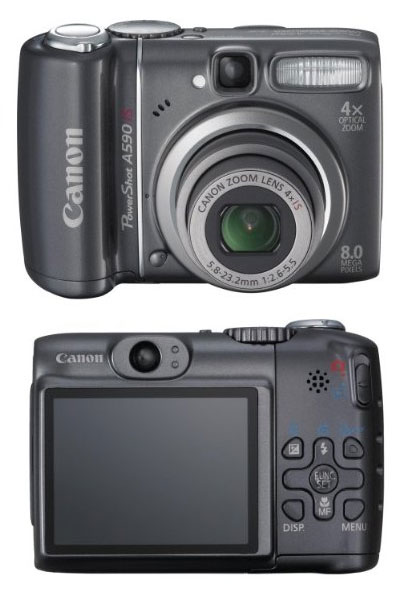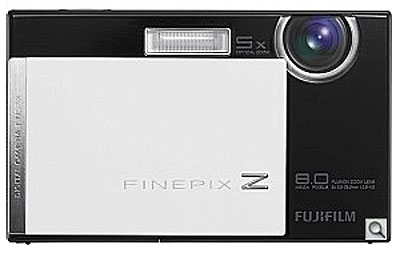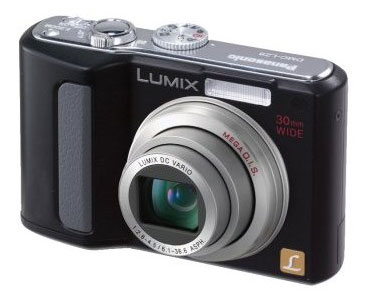Digital Cameras for the Holidays
by Wesley Fink on November 27, 2008 12:00 AM EST- Posted in
- Digital Camera
Entry Digitals
The entry Point-and-Shoot market is toughest of all to navigate. Every company seems to pile on more hype - most of which is meaningless - in an effort to persuade the unknowing into buying their camera. Before we make our recommendations, let's talk about a few things to avoid.
Digital zoom is totally meaningless and does nothing for your photos. It means either the camera chooses high ISO in low light or that the camera crops the picture it takes and digitally stretches the result to make it appear that it zoomed. Neither one does anything good for your pictures. The only zoom that matters is optical zoom, which is the zoom range of the fixed lens.
Image Stabilization - or IS, Mega OIS, VR, and other names - is important. Image Stabilization allows you to hand hold the shot in lower light than normally possible. This is very important with P&S since the tiny sensors always compromise ISO "film" speed and low light performance. Look for this feature as it makes a difference in the quality of the pictures you take.

For just over $100 you can buy the Canon Powershot A590 IS. The A590 lists for $149, and it's worth it, but a little shopping will find you an even better price. The A590 features IS (Image Stabilization), a very good quality 4x zoom lens (35-140mm equivalent), and a bright 2.5" LCD in an 8.0MP dark graphite body. It features the latest in face detection and motion detection technology and produces good quality images in full auto mode or the wide selection of scene modes that work well in tricky lighting.
Experienced users, or those who want to grow with their camera, will appreciate the range of control from all Auto to adjustable ISO, color, contrast, white adjustment, and sharpness/saturation. You also get Program, Aperture Priority, Shutter Priority, and full Manual , which is very rare in an entry level point-and-shoot. In addition to the 4x optical zoom there is an added 4x digital zoom that works better than most, but keep in mind that digital zoom is of much more limited use than true optical zoom.
The A590 is small but not tiny. In the end it delivers great images right out of the box in full auto mode - there's even an easy mode for complete beginners. When you want more, there is a very wide range of adjustments you can grow with. "Film" is SD or SDHC cards and power is two AA batteries - not bad for a camera that costs just over $100.

Some prefer a really tiny camera that fits easily in a purse, pocket, or backpack. A good choice for those who like thin and small is the Fuji Z100FD. This tiny camera actually packs a 5x (36-180mm) optical zoom and an 8.0MP sensor in that tiny body. It also delivers an excellent image for the cost of around $119 if you shop for it. It achieves super small size by using a small rechargeable Li-Ion battery and comes with the battery and charger. It does away with the optical finder to keep things small, but the LCD is a large 2.7". The Z100FD is also the first Z series to feature Image Stabilization and Automatic Red-Eye Removal.
The Z100FD is available in Shell Pink, Cappuccino Brown, and Tuxedo Black in addition to the standard Satin Silver. The colors will likely be a hit for those who want to tuck it in their purse, but you may have to pay more for colors other than Silver. When it was introduced, the Fujifilm Z100FD had a suggested price of $249, but it has dropped to $199 and can be found today at $115 to $120 at large etailers like Newegg and BuyDig.

Another excellent choice in the beginner P&S category is the Panasonic Lumix DMC-L8. This 8.1MP model features a 5x (32-160mm) optical zoom lens and an exceptionally wide ISO range of 100-6400. Other features are definitely competitive with the best in this category.
If you are wondering why all our choices are around 8MP, it is because of the tiny sensors used in point-and-shoot cameras. 8MP seems to be the sweet spot for current P&S sensors. You can still achieve a wider usable ISO range and keep noise reasonably low. When you go beyond 8MP with these small sensors, image quality deteriorates very fast. Our advice here is to avoid the 12 to 15MP point-and-shoots and stick to 7 to 9MP for best overall performance.










41 Comments
View All Comments
Wesley Fink - Friday, November 28, 2008 - link
We;ve added mention of the Pentax K20D as a great value at $750 to $800 in the Prosumer category. It is not, however, without its probelms, as is true of any camera, and the price has dropped from $1295 to $750 in pretty short order. Its an outstnding value if it fits your needs and the way you shoot.ubiloo - Friday, November 28, 2008 - link
Sorry, I meant 'for at least €100 less'computerfarmer - Thursday, November 27, 2008 - link
If I were to choose.......from this article.Point and shoot:
Panasonic Lumix DMC-L8 for quality, Canon Powershot A590 IS best for the money.
Super Zoom:
Panasonic Lumix LMC-TZ5
Entry Interchangeable Lens:
Canon XSi or XS and Panasonic G1
At this level, all make decent products....hard to choose.
Prosumer:
Nikon D90 or Canon 50D ....hard to choose.
Full-Frame:
Nikon D700 or Canon 5D Mark II
I am about to enter the "Entry Interchangeable Lens" category, perhaps in March or April. I have gone from point and shoot to superzoom. Panisonic FZ8 is camera I have now. It is so much better than the point and shoot. But the cost to go up to the next level is quite substantial. With a kit lens, I will not get the zoom I am accustomed too. The macro part I am unsure of. Then there is the flash. The number one reason for upgrading is the quality of photograph. The question I have is, if I wanted to print 13x19 inch photos, what camera and lens would do the best job for, Portraits, Birds, Indoors....
Example: If I purchased a Canon Rebel XSi; what else would I need to get the most out of this camera(general use). I am thinking the camera with the kit lens, plus a 200mm zoom lens, a macro lens, a flash(wireless would be nice), a good tripod. how much would this cost me?
This article gave a good overall view.....Thank You
strikeback03 - Monday, December 1, 2008 - link
Unless the birds are very tame, 200mm isn't very long. A friend of mine has the XTi with 18-55IS/55-250IS combo though and is very happy with them for general use. The 55-250IS is not that expensive, B&H has a kit with XSi/18-55IS/55-250IS for $708. The 100/2.8 Macro is a good macro lens and also very usable for tighter portraits, runs around $450. No Canon bodies offer wireless flash control in-body, so the flash itself ranges from $200-400 depending on power and features, and if you want wireless you either need remote triggers and external metering, or a ST-E2 wireless transmitter. Tripods are highly dependent on what you want and need, but guessing at least $100 is pretty safe.Note that for some items (lenses, flash) you can sometimes find third-party alternatives which work as well for your needs for less money.
haplo602 - Friday, November 28, 2008 - link
have a look on ebay ...I don't know the canon line of lenses, but something similar to the AF-S DX NIKKOR 18-105mm f/3.5-5.6G ED VR will make a good all-around starter lens.
Maxington - Thursday, November 27, 2008 - link
The G1 is revolutionary alright, its a camera that does away with the mirror box and optical viewfinder, without actually being any smaller than standard DSLRs!Why is this article have such a huge positive bias towards it? It should be applauded for actually trying, but totally dismissed until, like the rest of the 4/3rds range, it actually delivers on making a camera small. How you can recommend it whatsoever is beyond me.
Hell, Pentax have a far smaller setup, with the K2000/Km body, and their pancake lens range. And a better performing sensor with a bigger lens range to boot.
Speaking of Pentax, why were no Pentax cameras recommended? They are far better value for money than Nikon/Canon, though Sony camera bodies are probably the best value, pity their lenses are ridiculously priced.
Wesley Fink - Friday, November 28, 2008 - link
The G1 is a great deal smaller overall than any DSLR we have tested, but it also has many other features going for it, like the superb 3 inch tilt-and swivel hi-res LCD and the first EVF we could actually live with. It also breaks new ground in Live View AF.We agree the Pentax K20D is a great value at $750 to $800, and mention of the K20D has been added. It should also be mentioned that the price of the K20D has declined from $1295 to $750 in pretty short time. The pro-type sealing and 14.6 megapixel sensor are top of the class, but the high ISO noise, inconsistent color at high ISO, slow AF, and slow continuous frame-rates detract from the top-notch features.
gaston1 - Friday, November 28, 2008 - link
Thank you for adding K20D to the list. I agree about the AF being slower than the competition. High ISO noise, not really, I'd say it's in line with other APS-C cameras in its range, although Pentax has taken a different approach, producing grainier pictures at high ISO but preserving much more detail than the others (and can be cleaned very easily through software if one chooses to). ISO 1600 is very useable, 3200 is sort of equivalent to the K10D's 1600, not that clean but useful when needed, and the 6400 is not that useable, in my opinion. We must also not forget that most reviews (comparing jpegs) will have Pentax tested on its default setting with noise reduction off while it kicks in by default on other cameras once you start using higher ISO settings. Canon's ISO 12800 hardly contains any detail at all, and in my opinion is just there for marketing purposes.As far as value goes, Pentax shines when you start considering lenses. I strongly considered going for the Nikon D700 or even waiting for the Canon 5D mkII, both great cameras for low light (or landscape) photography. But after researching the lenses that I would need, the system price was quickly stretching far beyond my amateur's budget (although still a bargain if you're a pro and need the features). I even briefly considered Sony's A900 but had a similar issue with the cost of lenses.
strikeback03 - Monday, December 1, 2008 - link
I don't really see the advantage in Pentax lens prices that you mention. Seems like they have dropped some, as a year ago I initially recommended a K10D with 16-50 2.8 to a friend, expecting the 16-50 to be around $500. I was shocked to see it was around $900 at the time. At least now it is more reasonable. Checking other similar lenses they seem to be mostly in line with Canon/Nikon, with some deals (50/1.4 for $200) and some more expensive (the 77/1.8 vs 85/1.8 from others).Maxington - Friday, November 28, 2008 - link
Echoing what gaston1 said, thanks for adding the K20D to the list.Also echoing the high iso comment, Pentax has higher noise due to it retaining detail and not smearing it away like Nikon/Canon do. I'd rather keep the detail and post-process it later, with much better tools, than let the camera do it.
http://www.dpreview.com/reviews/pentaxk20d/page18....">http://www.dpreview.com/reviews/pentaxk20d/page18....
Look at the mush the others turn into.
I'm still not convinced the minor size drop the Panasonic G1 has makes it worthwhile. (It's about half a cm shorter than the Pentax Km, and about 2cm thinner) It's not small enough to drop into "pocket" range, especially with the lack of pancake lenses, thus any size benefit it has is pretty much pointless. It's still a DSLR to carry. When they get it down to being like a rangefinder, then it'll be worth looking at.
I do like the back lcd and the slick contrast af though.